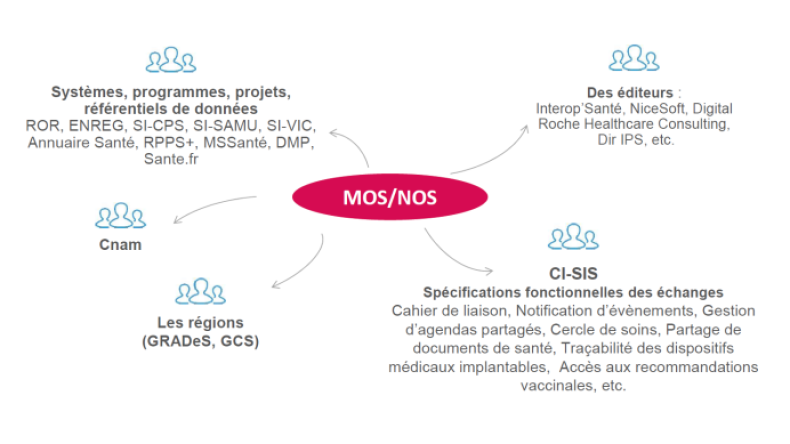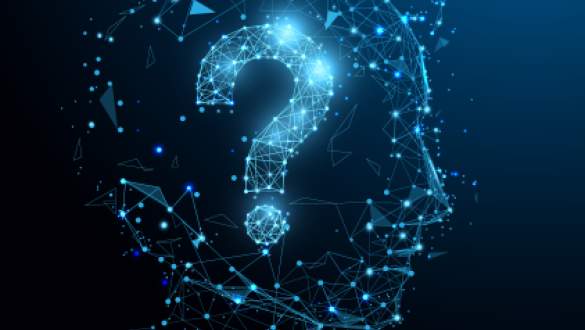Votre question concerne quel type d'offre ?
Votre question concerne quel couloir Ségur ?
Votre question concerne quel dispositif Ségur ?
Votre question concerne quel produit ou service produit?
Votre question concerne quelle thématique ?
All the resources for funding are available in our Ségur section for digital equipment.
Cette réponse vous a-t-elle été utile ?
Health professionals are encouraged to use MOS and NOS for three main reasons :
- enhance the interoperability of information systems by harmonising names, attributes, codes and nomenclatures;
- share the same understanding of the information, regardless of which directory or reference document it is taken from;
- facilitate the specification, analysis and conception of a project.
The ANS offers training on MOS-NOS and the elaboration method for exchanges’ functional specs (see our Documentation section).
The illustration below gives you examples of the types of professionals using the MOS-NOS:

Cette réponse vous a-t-elle été utile ?
For your application to be complete, you need to include several credentials and documents.
The list of documents and credentials needed is detailed in the Application form (download it below). You will need to send and application for each product you wish to label.
You must return your application form with all the supporting material by email AND via postal services:
- the complete application form needs to be sent by mail to:
Agence du numérique en santé (ANS)
Labellisation logiciel Maisons et Centres de Santé
9, rue Georges Pitard
75015 Paris - follow up with sending digital versions (PDF scans) of the agreement and its annexes, in two copies, signed and completed to:
Cette réponse vous a-t-elle été utile ?
Your level of access to the ROR data depends on the nature of the data you wish to use (public/restricted) and the perimeter you wish to cover (one ROR or several ROR directories).
The ROR data in public access:
- is available as opendata since mid-2022;
- will be available directly on the national ROR with no specific procedure in early 2023.
The ROR data in restricted access (professional access):
- for one regional ROR, you must complete a request form to join the regional circle of trust and send it to the region’s GRADeS;
- for several ROR directories, you must complete a request form to join the national circle of trust and send it to the ROR program team.
Cette réponse vous a-t-elle été utile ?
The MOS is a collection of concepts described homogeneously and neutrally in terms of technologies. It offers a common description of the information processed and exchanged in the information systems to make digital communication easier.
The overall consistency of the MOS is founded on the definition and description of its UML (Unified Modelling Language) concepts.
Some MOS concepts can be coded. They are associated with the nomenclatures of health objects (NOS), i.e. lists of codes/labels.
You are encouraged to use MOS and NOS to :
- optimise and coordinate efforts when you analyse or conceive a system (or an application) by re-using the same semantic components;
- make sure there is consistency in your internal developments and with external systems, for the best possible interoperability.
Cette réponse vous a-t-elle été utile ?
The European Commission’s studies have determined there is a need for a base vocabulary, such as MOS and NOS, which can be used as a starting point for:
- develop and evolve information systems (IS) to formalise the conceptual and logical data they utilise (for instance, the MOS is a reference for the modelling of the RPPS);
- share information between ISs to create specific models of data they can use (thus, the MOS is underlying the ROR exposure model);
- combine and synthetise elements originating from different sources;
- publish data in a common format, such as a directory or catalogue of service (for example, the Annuaire Santé / Health Pro Directory).
Cette réponse vous a-t-elle été utile ?
When your software gets the label attribution, the successful candidate will receive by email the visual elements you will need to communicate about it.
The editor of the solution (or the solution range) will receive the label after signing the agreement with the ANS. They will be able to use the label on commercial publications, technical documents, with no particular restriction on the type of format used (paper, Internet, intranet, etc.)
The recipient must mention the level of the label (1 or 2) they obtained. These specifications are set out in the Functional referential (in our Documentation section)
Cette réponse vous a-t-elle été utile ?
A base product (“Produit socle”) is a solution, a service, or device sold by an eHealth industrial, which is aimed at fulfilling the needs of a particular activity, practice or profession. It is not bound to the purchase of a previous product. It may be completed with Option Products (“Produit option”) to extend its functional coverage.
An option product (“Produit option”) is a solution, service, or device sold by an eHealth industrial to meet specific needs extending the functional perimeter of one or several base products (“produits socle”) to which it adds on. This means a base product must be purchased, prior to the use of an option product.
In the case of a base product being offered as an option to another product, we suggest you first declare the product as a “produit socle”. Then you will be able, from this entry, to duplicate and convert the product as a “produit option”.
Cette réponse vous a-t-elle été utile ?
PLATINES is a platform dedicated to interoperability tests for eHealth. It stimulates a ROR (version 2.4) and gives you the opportunity to use “test” data via several professional cases (a total of 94 test scenarios are available). These test scenarios are valid for the current ROR as well as the national ROR.
You must contact the ROR program team to request access to PLATINES.
Cette réponse vous a-t-elle été utile ?


